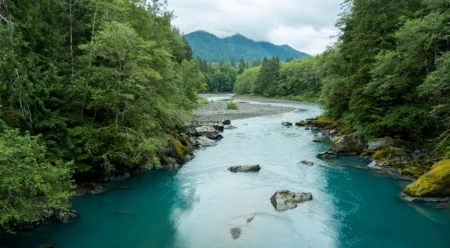Saving One River: Hoh Steelhead in Decline
“Nature provides a free lunch, but only if we control our appetites.”
A coho salmon the size of my pinky drifts quietly in the shade. It’s hardly distinguishable from the sand below. But Marie-France Roy, a professional snowboarder who does volunteer habitat- enhancement work in her hometown of Ucluelet, BC, has a sharp eye for salmon, especially after a week in the backcountry.
Marie crouches and points to the fry. “There are more of them,” she whispers. “The water’s so clear…”
Resting six inches deep in a tiny side pool of Washington state’s Hoh River, the piscine youth senses our presence and plays it cool. It’s a wild fish, learning to survive here in Olympic National Park before making its way to the Pacific Ocean. Hopefully, in a few years it will return to the Hoh to spawn.
It’s the first fish we’ve seen since Marie, professional snowboarder Kael Martin and I started on this eight-day, multi-sport adventure. Seven days ago, we started pedaling mountain bikes from the mouth of the Elwha River in mid-June, following its path into the Olympic Mountains and the flanks of the range’s abundant glaciers. There we swapped wheels for splitboards and hiking trail for skin track, until a few days later we snowboarded down the 7,980-foot summit of Mount Olympus, the tallest peak in the range, and onto the Hoh Glacier. Then it was out of the mountains along the Hoh River, having followed a healing river to its source and a healthy river to the Pacific Ocean.
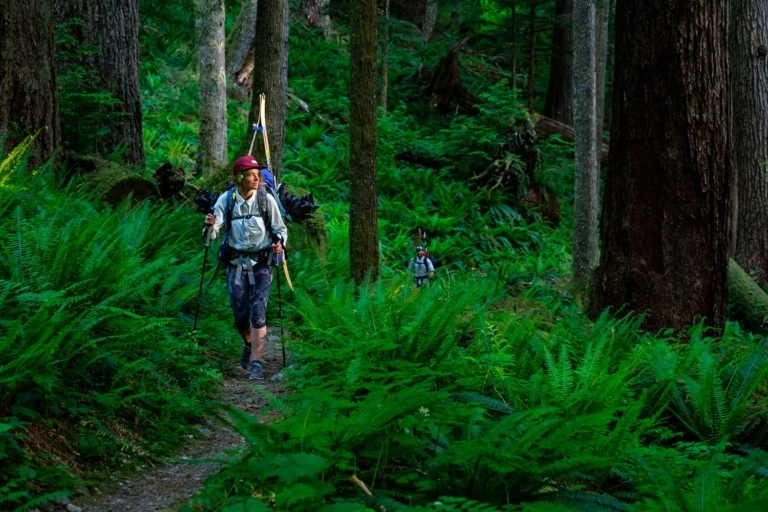
Marie-France Roy and Kael Martin descend along the upper reaches of the Hoh River Trail seven days into an eight-day traverse through the Olympic Mountains. We’d finally swapped soggy snowboard boots for dry shoes, and as we walked through the temperate rainforest, the sunset bathed the old-growth with golden light. Photo: Colin Wiseman
Our first goal was to see how the former, the Elwha, is recovering from a historic dam removal project completed in 2014. The second was observing the state of the latter, the Hoh. Although it isn’t home to the largest runs on the Olympic Peninsula, the Hoh’s native steelhead have long been known for their prolific size and genetic strength, with individual fish growing to nearly 30 pounds.
The river, however, is under siege, particularly when it comes to those wild steelhead. The population faces a plethora of challenges, predominantly heavy harvesting and competition with hatchery fish. And in the fight to save a wild steelhead population in decline, the Hoh River is ground zero.
Downriver from Marie and the fingerling, the ribbon of silty blue water flows through a steep canyon before widening as the terrain softens. The 50-mile river is lined with plentiful gravel bars where salmonids can build nests known as “redds,” and an even larger web of unaltered tributaries descend from the lofty crags hemming in the 299-square-mile watershed. Most of these waterways run within Olympic National Park, 922,650 acres of primeval, federally protected temperate rainforest that receives up to 12 feet of precipitation each year.
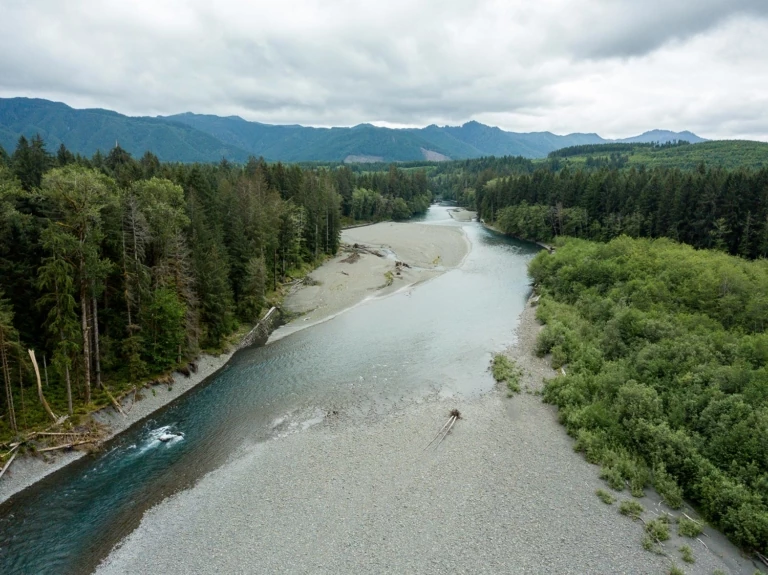
A healthy river will do as it pleases, be it flood its banks, reshape its channel or change course completely—meaning the rocky spits that appear to hem it in are actually just open spaces for the water to move. Photo: Colin Wiseman
“The park protects 58 percent of the Hoh’s watershed,” Sam Brenkman, Olympic National Park’s chief fisheries biologist, told me. “From a habitat standpoint, the upper river is as good as it gets. Wild steelhead are a precious resource to Olympic National Park and beyond, and these steelhead are of high ecological, recreational and cultural importance. The park is a really important sanctuary for anadromous fish.”
Even outside the park, the Hoh River is surprisingly lonely: it’s a two-hour drive to Port Angeles, at 20,000 the nearest population center, and the Hoh watershed is still hatchery-free.
With its lack of a resident hatchery and relatively abundant steelhead population, the Hoh could be an ideal location to create strong data on the resilience of purely wild populations. Dick Burge, a now-retired biologist from the Seattle-based Wild Steelhead Coalition (WSC), suggested as much in a 2010 paper. Indeed, that the Olympic Peninsula is one of the last remaining steelhead strongholds in the Pacific Northwest is also the rub. Wild fish that do make it to the spawning grounds on the Hoh must fight their way upstream through an increasing number of anglers, and its winter steelhead population is dwindling. According to the WSC, in 1920 wild steelhead returns on the river were estimated at 35,000–59,000 fish. Nowadays, Washington Department of Fish and Wildlife (WDFW) data suggests it’s common to see fewer than 4,000 wild fish; in 2016-2017, the number of winter steelhead dipped to less than 2,300. Only those that avoid harvest will have a chance to spawn, a figure biologists call “escapement.” The WDFW’s escapement goal for the Hoh is a relatively low 2,400. That number has only been met four out of the past 10 years.
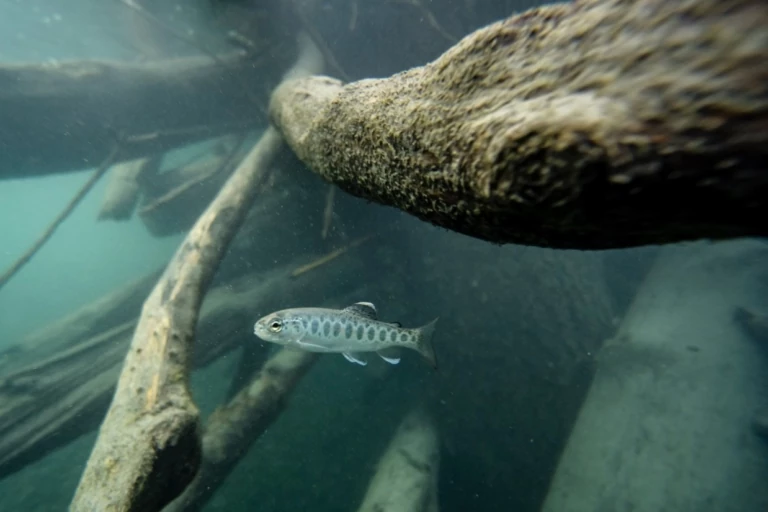
In 2011, Washington state’s Elwha River Dam—located on the northern edge of the Olympic Peninsula—became the focus of the largest dam removal in U.S. history. When the Glines Canyon Dam met the same fate three years later, young anadromous fish could swim the length of the Elwha for the first time in over a century. Photo: Mark McInnis
“The science that’s used to update those escapement goals hasn’t kept pace, and it has also missed a lot of the improvements and knowledge about the biology of steelhead,” says John McMillan, science director for Trout Unlimited. To update that knowledge, the group worked with WDFW to purchase a sonar unit, a tool that could more accurately measure run sizes, but funding was dropped after only two years. “It’s really hard to set harvest numbers when the science behind escapement estimates isn’t reliable.”
Add in the human variable, and this becomes even more difficult. One example is the Hoh Tribe, whose traditional fishing grounds include the mouth of the Hoh River. As the area’s native inhabitants, it’s the tribe members’ federal right to harvest these fish, and the river’s salmonid population provides an important source of income for a community with high levels of poverty. Tribal fishermen often use gill nets, which produce an undesirable level of drop-out mortality—fish that die in the net but fall out before being harvested—that isn’t counted against the tribe’s quota. More efficient fishing techniques could be introduced within tribal fisheries, but the Hoh Tribe’s federal right to fish makes imposing further restrictions difficult in comparison to sport anglers. That, however, doesn’t mean sport anglers are blameless.
“We’ve got more anglers out here, and we’ve got smaller populations of fish in recent years,” McMillan says. “The reasons we have more anglers is because most of Puget Sound is closed for steelhead fishing, and other places have closed, so anglers tend to descend out here and aggregate. In 2014 on the Hoh, the [WDFW] estimated that anglers caught every fish that escaped in the fishery an average of 1.4 times.”
According to WSC’s Dick Burge, there’s an estimated 10-percent mortality rate for catch-and-release fish (the “fishery” here being the area where anglers do their fishing) mostly due to injuries from hooking and handling. Couple that with the stress of being caught and aggressive anglers disrupting their nests, and the result is fish have less energy for reproduction.
“I think the Hoh’s been loved to death,” says Rich Simms, founding board member of the Wild Steelhead Coalition. “I’ve fished it my entire life, and I’ll continue to fish it periodically, but I’ll know when to stop as well. Are people willing to just go out and catch a single fish for the day and be happy about it? We need to change the mindset and expectations of sport fishers as well as change to more sustainable, selective methods in commercial tribal harvests if we want to help reverse the trend.”
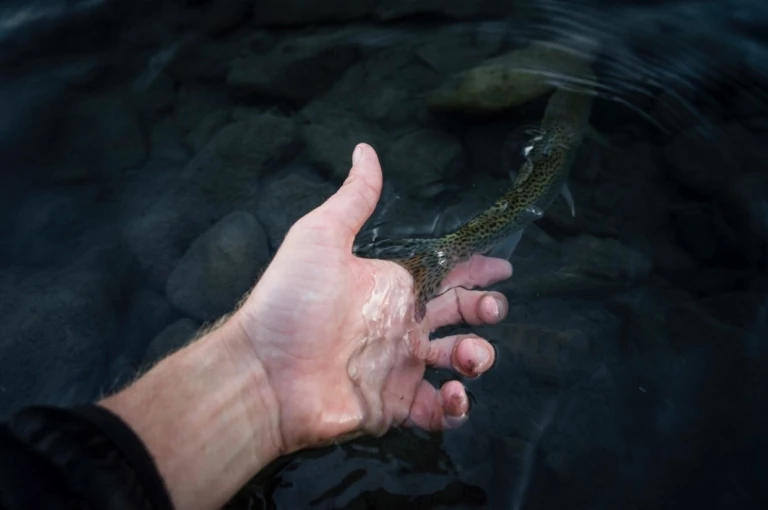
A young fish on its way down the Elwha to the Pacific (after a brief interruption). Photo: Mark McInnis
Then there’s the hatchery issue. Despite the absence of a hatchery facility on the Hoh itself, over the past century nearby state and federal hatcheries have released millions of fish into the river. With them come the inherent problems of mixing hatchery fish with wild populations: competition for limited resources, and damage to the gene pool from an influx of domesticated hatchery genetics, caused by interbreeding between wild and hatchery fish, among other things.
Removing hatchery steelhead has shown promise as part of a wild salmonid restoration plan on numerous western waterways in recent years. For instance, take Puget Sound’s threatened Skagit River, itself a former steelhead stronghold. In 2009, wild winter steelhead returns dipped to below 2,500 fish. A moratorium on steelhead fishing in the river in 2009, coupled with a 2014 lawsuit halting hatchery release programs and continuing habitat enhancement efforts, has resulted in a rebound to an estimated 6,000–8,800 wild fish returning per annum in recent years. With that came the limited reopening of the river to catch-and-release anglers in 2018, and removing hatchery steelhead could provide even more invaluable data to scientists working on salmonid recovery problems.
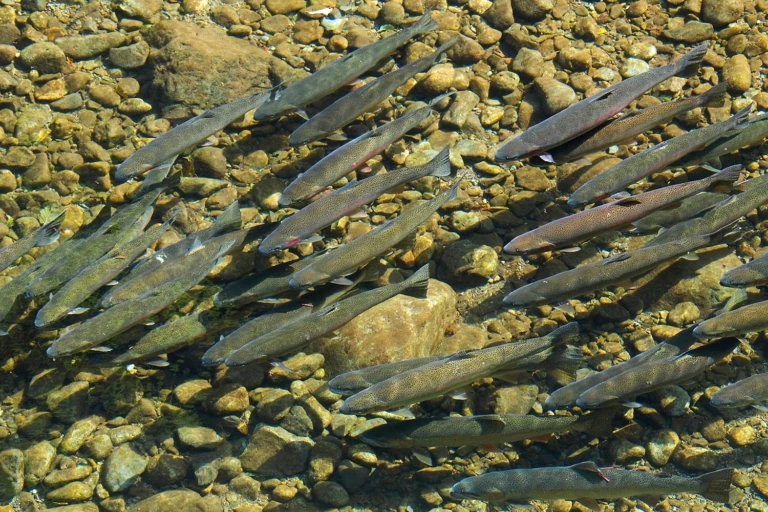
The Olympic Peninsula—and its anglers—know how to keep a secret. A school of steelhead navigate an unnamed Washington river on their way to spawn. Photo: Jed Weingarten
Doing so, however, takes even more effort. Like McMillan, Simms suggests starting with stronger data, dedicating more resources to calculating natural predation rates and using sonar technology to obtain more accurate fish counts. But this would require increased funding, one possible source being increased fees for anglers and guides on the Olympic Peninsula—particularly those already spending significant money to visit from out of state. An out-of-state guide license for sport fishing only costs $760, which isn’t much more than a single day of guide fees.
“Now that the Olympic Peninsula has become a popular destination for anglers and guides from out of state, we should make people pay for it more like they do in Canada and other destination fisheries,” Simms says. “I’m not sure it is going to alleviate the pressure on the fish, but at least it would provide some funding for things we’re trying to do, such as getting our sonar up and running on the Hoh to provide better monitoring and increased law enforcement.”
Such ideas are usually countered with arguments about supporting the local economy—but what kind of angling economy will exist when the fish are gone? As renowned environmentalist David Brower says, “There’s no business to be done on a dead planet.”
“Everybody wants the fish to succeed, but no one’s really willing to make the sacrifice when it comes down to actually changing their behavior,” Simms says.
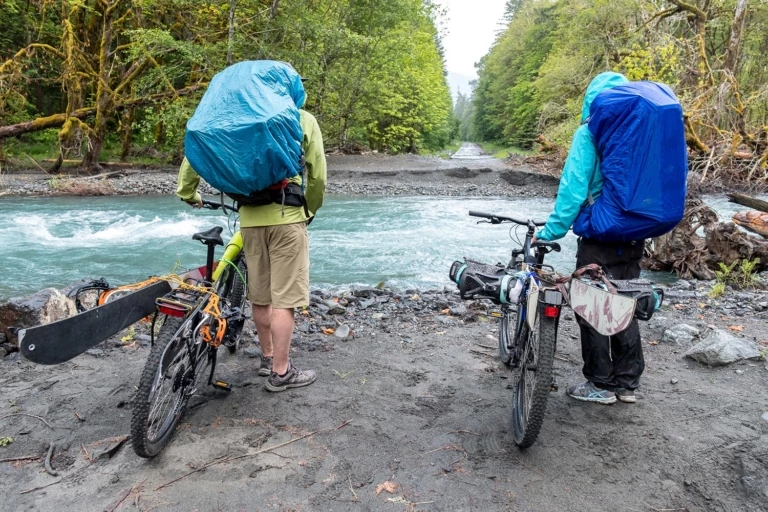
Wild rivers will do wild things. Marie-France Roy and Kael Martin contemplate a major road blow-out along the Elwha River and potential end to the bike-assisted portion of their approach to Mount Olympus. Photo: Colin Wiseman
In its current state, the Hoh is one of the few rivers in the Pacific Northwest with a strong chance of rebuilding a purely wild steelhead population, and it’s had help doing so. To protect fish traveling between the ocean and the relative safety of Olympic National Park, for example, the Western Rivers Conservancy—in conjunction with the Hoh River Trust, the Nature Conservancy and the US Fish and Wildlife Service—have spent two decades acquiring over 10,000 acres of timberland surrounding the Hoh downstream of the park, ensuring it wouldn’t see further damage. Members of the Hoh Tribe have put significant effort into habitat restoration on their land as well. With close monitoring, reduction in harvest through better fishing techniques and less pressure from sportfishing, we could be on our way to strengthening the model for sustaining, and maybe even rebuilding, wild fish populations in other locations with suitable habitat.
“If we can’t change our behavior to accommodate steelhead, it’s a bad sign for our future,” McMillan says. “Perhaps no population is more important to anglers than the Hoh River. If we can’t save one river, how are we ever going to deal with larger issues like climate change?”
Indeed, action at the local level begets far-reaching change. Saving the Hoh’s steelhead is just a first step in addressing larger issues surrounding salmonid conservation on a global scale, from hatcheries to harvest to oceanic conditions writ large.
As Marie, Kael and I descend the Hoh toward the park’s visitor center, we encounter more and more people. We pass numerous side pools where young coho salmon hold in the cool water. Yet we don’t see any steelhead. I wonder how many are out there in the expansive waters of the Hoh, swimming wild and free.
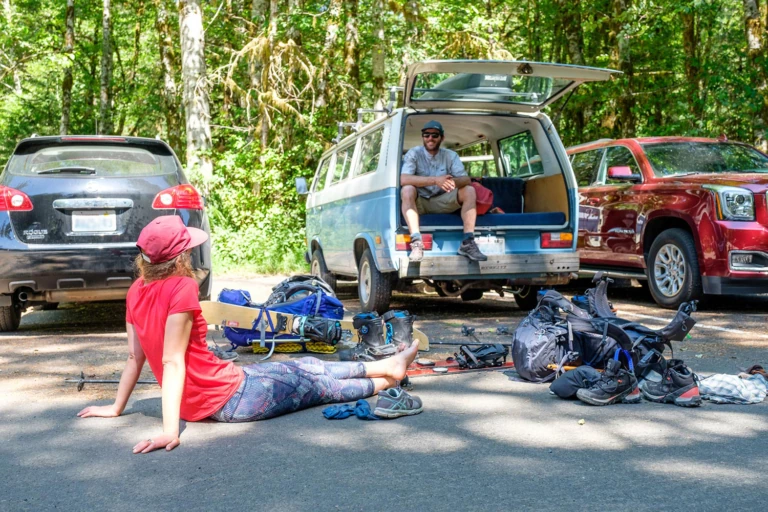
After traveling eight days and 65 miles through snowy peaks, alpine meadows and deep rainforests, Marie-France Roy and Kael Martin take a celebratory gear explosion at the Hoh River trailhead. Photo: Colin Wiseman
In an effort to save endangered rivers like the Hoh, and the wild fish that call them home, Patagonia has produced a feature-length film entitled Artifishal. It explores wild salmon’s slide toward extinction, threats posed by fish hatcheries and fish farms, and our continued loss of faith in nature. The online release of the film is coming in September. Learn more and sign the petition.
To hear more about Colin, Marie and Kael’s trip across the Olympic Mountains, visit Done in an R1® at Patagonia.com.
